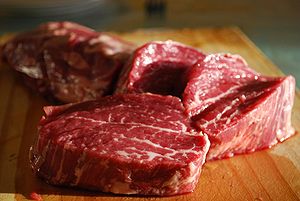Courtney and I took a trip to Long's Meat Market this weekend to pick up our weekly chicken (likely the only meat we will eat this week), and on the way there we saw a horse drawn carriage, driven by two men in complete western regalia with requisite handlebar mustachios, loaded with several cases of Ninkasi beer. I felt a little like I was living in some weird holiday beer commercial for a moment, but it passed. When we arrived at Long's, we were surprised by a long line outside. At first I thought they were really busy, but soon it became obvious that the line was not to get in, it was leading to a pop up tent where some men were grilling hamburgers and handing out samples of beer. All for free. Needless to say, we got in line.
As we learned eventually, the event was a launch for a new beef company called Oregon Natural Meat. They claimed that their product is more environmentally friendly, because they upcycle grain to feed their cattle. I was highly skeptical, but willing to eat the free food all the same. Shortly before we got to the front of the line, the beer commercial caught up with us. Turns out those cases of Ninkasi we had seen on the way were headed for us. The horse drawn cart pulled into the parking lot, and the cases of beer headed for the sample stand.
I stated in a previous post that Concentrated Feed Lots are really damaging to the environment, and that grass finished beef was significantly more eco-friendly, but sure enough, as soon as you make a rule there is an exception. ONM fattens their cattle on grain before slaughter, but they do it very differently. First of all, they are a small company which only distributes locally, so there isn't the pollution issue of concentrated feed lots. Because they are small and family owned, there is more oversight in the process, and the health of the animals is observed rather than assumed. They are fed a grain diet for richer meat, but unlike the concentrated feed lots the diet is 100% vegetarian, with no antibiotics or growth hormones, no animal byproducts, and (the most disgusting CFL practice, in my opinion) no manure.
A substantial portion of the feed comes in the form of malted barley that has been used to brew beer, a byproduct of the brewing industry (in fact it comes from Ninkasi, hence the horse connection). So the primary ingredient in their diet is something that would be waste, isn't fit for human consumption, but is good for them. They explained this whole concept with a very informative seeming info graphic which actually was just pretty and not really very informative:
Aside from 'upcycling' the used grain, ONM seems to do everything else right as well. They are devoted to sourcing all of their cattle and suppliers locally, and only distribute locally as well. They handle the cattle as humanely as possible, and don't engage in the breakneck speed processing that most large meat packers do (the pace of conventional meat packers reduces quality control and increases the rate of human injuries). The result is beef that is good enough for the finest steak house, produced in an ecological and healthy manner.
 Image via Wikipedia
Image via Wikipediareally great, because while grass fed beef is delicious, it is leaner and a little more gamey. If you know this going in, it is a perfectly wonderful taste, but many restaurants shy away because their customers expect the flavor and texture of grain fed beef. A company like Oregon Natural Meat is a perfect solution, because they produce a product that is superior to conventional beef in every way and is much closer to being sustainable.



No comments:
Post a Comment